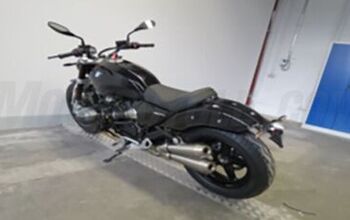3 Views
200-inch Baby-Block Chevy-Engined Motorcycle!
by
George Obradovich
(IC: )
Published: July 31st, 2003
Share
A key concept in combining the most power with the most utility (eg, acceleration balanced with handling and braking) is compactness and light weight of the powerplant.
At one extreme, you can rev a tiny, lightweight engine to turbine-like speeds to produce lots of power and end up with a light, great-handling bike with a peaky motor. At the other extreme, you can just drop in a Chevy V8 engine and get massive power at the expense of handling and braking.
But the concept of the small-block Chevy in a motorcycle frame is interesting in that it's even possible. Why is it possible? Because the small-block Chevy is incredibly compact for its displacement.
The first small block was 265 cubic inches. The largest produced was 400 cubic inches. All within the same external size -- no more than about 30 inches in length, width, or height. That's compact!
It's also light for a car/truck engine, just under 500 lbs. An aluminum version is at least 100 lbs lighter.
And because of the large displacement, it could produce substantial power and torque in a very mild state of tune. For example, the 400-cubic-inch passenger car version from 1970 produced 265 hp at 4400 rpm and 400 ft-lb torque at 2400 rpm with a two-barrel carb and 9.0:1 compression. (Those are gross hp and torque figures; net would be around 220 hp and 325 ft-lb.)
So we have a package 30 inches long, 30 inches wide, and 30 inches tall that displaces 400 cubic inches and produces over 200 hp and 300 ft-lb of torque and weighs in in aluminum form at under 400 lbs.
Here's where it gets interesting. (You are now saying "I was HOPING it would get interesting after reading all this!")
Imagine scaling the small block down to half size:
15 inches long, 15 inches wide, 15 inches tall
200 lbs (in aluminum form)
200 cubic inches, 100 hp @ 4400 rpm, 150 ft-lb of torque @ 2400 rpm
Does this sound like a killer cruiser engine or what?!
Actually, it could be tuned to be a killer touring or sport-tourer engine also. Small-block Chevys have no problem making a tractable 1 hp/cubic inch, especially with electronic engine management.
So at about the same size as a Valkyrie or Gold Wing engine, you could get 200 cubic inches (or 3.2 liters) with a tuning potential from 100 to 200 hp.
The question is, why hasn't somebody done this? There are lots of aftermarket small-block Chevy engines being built. It would be no big engineering deal to scale one down.
Efficiency would actually improve in a scaled-down version because smaller parts have less inertia, airflow is easier to manage in smaller volumes, etc.
I really, really want to see someone build one of these. :-)
Get Motorcycle.com in your InboxAt one extreme, you can rev a tiny, lightweight engine to turbine-like speeds to produce lots of power and end up with a light, great-handling bike with a peaky motor. At the other extreme, you can just drop in a Chevy V8 engine and get massive power at the expense of handling and braking.
But the concept of the small-block Chevy in a motorcycle frame is interesting in that it's even possible. Why is it possible? Because the small-block Chevy is incredibly compact for its displacement.
The first small block was 265 cubic inches. The largest produced was 400 cubic inches. All within the same external size -- no more than about 30 inches in length, width, or height. That's compact!
It's also light for a car/truck engine, just under 500 lbs. An aluminum version is at least 100 lbs lighter.
And because of the large displacement, it could produce substantial power and torque in a very mild state of tune. For example, the 400-cubic-inch passenger car version from 1970 produced 265 hp at 4400 rpm and 400 ft-lb torque at 2400 rpm with a two-barrel carb and 9.0:1 compression. (Those are gross hp and torque figures; net would be around 220 hp and 325 ft-lb.)
So we have a package 30 inches long, 30 inches wide, and 30 inches tall that displaces 400 cubic inches and produces over 200 hp and 300 ft-lb of torque and weighs in in aluminum form at under 400 lbs.
Here's where it gets interesting. (You are now saying "I was HOPING it would get interesting after reading all this!")
Imagine scaling the small block down to half size:
15 inches long, 15 inches wide, 15 inches tall
200 lbs (in aluminum form)
200 cubic inches, 100 hp @ 4400 rpm, 150 ft-lb of torque @ 2400 rpm
Does this sound like a killer cruiser engine or what?!
Actually, it could be tuned to be a killer touring or sport-tourer engine also. Small-block Chevys have no problem making a tractable 1 hp/cubic inch, especially with electronic engine management.
So at about the same size as a Valkyrie or Gold Wing engine, you could get 200 cubic inches (or 3.2 liters) with a tuning potential from 100 to 200 hp.
The question is, why hasn't somebody done this? There are lots of aftermarket small-block Chevy engines being built. It would be no big engineering deal to scale one down.
Efficiency would actually improve in a scaled-down version because smaller parts have less inertia, airflow is easier to manage in smaller volumes, etc.
I really, really want to see someone build one of these. :-)
George Obradovich
More by George Obradovich
Published July 31st, 2003 6:00 AM
Motorcycle Insurance



























Comments
Join the conversation